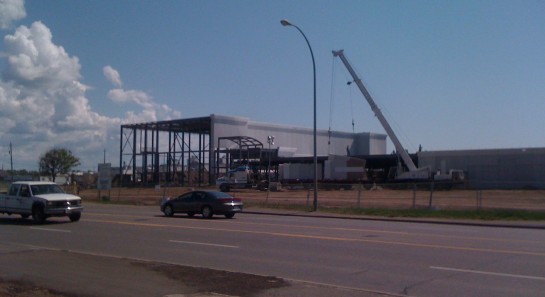thinking: “oh, look honey, another box store.”
Thunder Bay’s Intercity area is a commercial developer’s (and realtor’s) wet dream: dozens of flat, undeveloped acres sandwiched between two car-dependent city-regions. You couldn’t make that up. Naturally, this is where the box retailers are making their inevitable home.

Leon's Furniture construction on Water Street.
For some, this development has been cause for concern, specifically as an economic (and social) drain on the downtown cores of Port Arthur and Fort William. We can’t really comment on that; we’re not economists. Our concern is more centered on how these buildings are so consciously removed from the cultural landscape of the region.
box model
Box store and mall architecture is fascinating. Immense, windowless, hollow structures whose sole purpose is to house goods for resale in high volumes as efficiently as possible. That’s it, really – there isn’t a single other thing for which these steel caves are intended or even conducive. Not community, not culture, not development – just short-term commerce. And that’s great, since commerce means jobs and taxes, which means people can eat and then have the waste taken away. Life is good.
The other fascinating feature of these large-scale commercial structures is their facade design. When considered, they’re really very clever; they have to be appealing to the greatest number of people possible across the greatest number of communities in the greatest number of possible contexts, while maintaining something of the retailer’s brand. They have to be utterly, completely, even tyrannically ‘normal’. They have to situate nowhere in order to fit in everywhere. Designing a storefront for your standard big box retailer would have to amount to the most difficult project a designer would ever have.
a failure to communicate
A design process is best led by a definition of goals, usually communicative ones. Whether through something as direct and temporary as an advertisement or as expressive and deep as an identity, the client always wants to communicate something specific to someone specific. That defined goal fuels a designer’s process – without it, design is toothless and meaningless. It comes from nowhere, and goes nowhere. It amounts to mere doodling; perhaps pretty doodling, but still doodling.
In a manner of thinking, the designer for a box retailer’s exterior has a specific goal: communicate as little as possible to as many people as possible. In another manner of thinking, that goal is not a goal at all, but rather a non-goal – if that makes sense – the avoidance of anything directive. Forgetting for the moment that not communicating something is impossible, a box retailer designer must actively steer clear of any contextual references, while still making it somewhat ‘attractive’. The result is more often than not flat, neutral surfaces punctuated by a peak here or there and topped with, predictably, crown molding. The result is a mishmash of visual cues that successfully say very little of anything to just about anyone.
The net effect is a massive, characterless embodiment of consumerism hogging the visual landscape, and a persistent accusation that our priorities as a community have been reduced to simply buying lots of stuff at low prices.
breaking the box
It doesn’t have to be this way, of course. Many (if not most) communities now require big box retailers to adhere to a set of architectural and landscaping guidelines to protect the cultural character of the place, and to limit the often undesirable consequences of big box developments – vast parking lots, traffic congestion, urban and automotive sprawl, etc.

During the 70's and 80's, Best had SITE design several of its stores. (via ouno design)
But such things need not be regulated. The businesses themselves could take a more sensitive and even adventurous approach on their own accord. Even decades ago, the big box retailer presence – and its role in the community – was a matter of question, a question that was approached by at least one chain. In the 1970’s and 1980’s, BEST hired architect James Wines’ SITE to design nine stores that challenged the role of art in retail spaces, and was “a way of asking questions and changing public response to the significance of commercial buildings in the suburban environment.” (More pictures here.)
making our own box
What should a box store for Thunder Bay look like? How should it be visually and culturally accountable to our community? These are questions that should be asked if we are serious about protecting and enabling the things that really matter to a community.
There is also the question of what to do with these architectural monstrosities once they’re abandoned. After all, they were built with one purpose in mind, and that purpose will expire at some point (to wit, Walmart has its own realty division to handle its current and former properties). Many enterprising folks have already been answering that question with ingenuity.
Last year, magazines inhabitat and dwell co-sponsored a competition called ReBurbia, in which competitors were asked to envision the future of the suburban landscape, especially abandoned big box stores and McMansions. The results yielded some clever solutions for that future, and even some thoughtful solutions for the present.
So, there are options. Our task as a community is to have the courage to take ownership of our visual landscape, and then have an equal amount of courage to allow communities to develop naturally as these retail spaces inevitably burn out.
In the mean time, there are other ways to comment on the totalizing effect of big box retailers on consumer habits and choice. Enjoy:
//


Great post…
Here’s a TED video that I found that shares many similar ideas:
http://www.ted.com/talks/ellen_dunham_jones_retrofitting_suburbia.html
“Ellen Dunham-Jones fires the starting shot for the next 50 years’ big sustainable design project: retrofitting suburbia. To come: Dying malls rehabilitated, dead ‘big bo’ stores re-inhabited, parking lots transformed into thriving wetlands.”
Thanks Ben! That video provides many excellent examples of what I actively support to happen in 10-20 years time, when the current Intercity developments burn out. Finally, perhaps, the two cities will actually become one.
Hi guys, tripped on your website on a mention from my stepson who lives in Thunder Bay. Nice site. I disagree that urban design does not have to be legislated. It most certainly does, because most of this bad design comes from head offices bend on moving customers and products at the lowest possible cost, without regard for local visual culture. Cities such as Scottsdale, Arizona have legislated very specific design codes for their local environments. And they work, at least better than cities such as Thunder Bay, Sudbury, Kingston and most of the country.
The small town in which I presently live, St. Andrews, NB has very stringent local policies limiting ANY outside retail influence. As a result, the community is completely intact and a pleasure to walk. That’s right. Walk.
Thunder Bay is a city which has lost its vision, its reason for existence. That comment about cheap, desperate, etc. in your other post is very apt. It is also labouring under some very profound social pressures, most obviously the growing aboriginal population. The city leaders and administrators seem to have as poor a grip on this as they do development.
In short, most of the city is becoming a slum. It makes me very sad. You are very correct in observing (elsewhere) that beauty is more than skin deep. And good design can affect profound change. But ‘aspiration’ is an even more profound, and necessary precursor and motivator.
Anyway, keep up the very good work! You can check out my blog piece on my last visit “home” if you like.
geraldmceachern.blogspot.com/2010/08/down-endless-spiraling-road.html
Cheers! -G.
Gerald, thanks for the comments! They’re very much appreciated, especially from a fellow designer!
I admit that I struggle with the idea of protective legislation; in my mind, it’s a result of eternally hopeful ‘classical’ liberal ideology and normative behavior clashing with a sober recognition of economic and social reality. So while I do believe that legislating urban design *shouldn’t* have to happen because retailers *should* know better (and I would even go so far as to argue that such legislation could potentially restrict the natural development of local culture), I ultimately and completely agree that they are needed to preserve the existing local character of a place and protect the existing fabric of culture.
However, just what local character is there to preserve in Thunder Bay? I only mentioned the question in passing in the post, but what sorts of legislations would make sense here – what would a box store in Thunder Bay look like? I don’t think anyone has an answer, partly because there is nothing ‘definitive’ about the built environment in Thunder Bay, at least nothing that could be integrated into a box store.
As for our local cultural fabric, well, that is something else. It’s clear to anyone with senses that the Intercity and other ‘mall’ developments have nearly destroyed the pre-existing business and community cores around the city. Only through determination and insight have areas such as Bay & Algoma buoyed up recently in defiance of other developments, and more are on the way.
You mention that Thunder Bay has lost its vision, but I wonder if that wasn’t simply a matter of course, or if it had any in the first place. Thunder Bay’s mainstay economy has been hemorrhaging over the last 15 years (or more) – what does that do to a community’s sense of self, to its ‘reason for existence’ (I include the tax base in there too)? I suggest we watch what happens to Windsor and other communities that are/were reliant on the automotive industry and see what happens as they try to find themselves over the next decade or so.
Rather than bemoan it, I think we ought to simply recognize it for what it is: an opportunity. An opportunity to reimagine, rediscover, reinvent, and re-emerge. I mentioned briefly in the previous post that Thunder Bay is currently undergoing a ‘Culture Plan’ process (with some observations to be announced at the end of the month – I’ll likely provide my take on them here), which I see as an indication that Thunder Bay is attempting to do just what I say – reimagine its future, rediscover its present, reinvent its way forward, and re-emerge from the shell of its former self, all the better for its struggles.
Thanks for the link – I encourage anyone reading to pop over and give it a read! Every perspective on Thunder Bay is valuable and needed, and yours are full of great insight.
And cheers to and yours!
[…] on big box architecture (“caves of commerce”) in Thunder Bay, eleven-seventeen has this to say: The other fascinating feature of these large-scale commercial structures is their […]